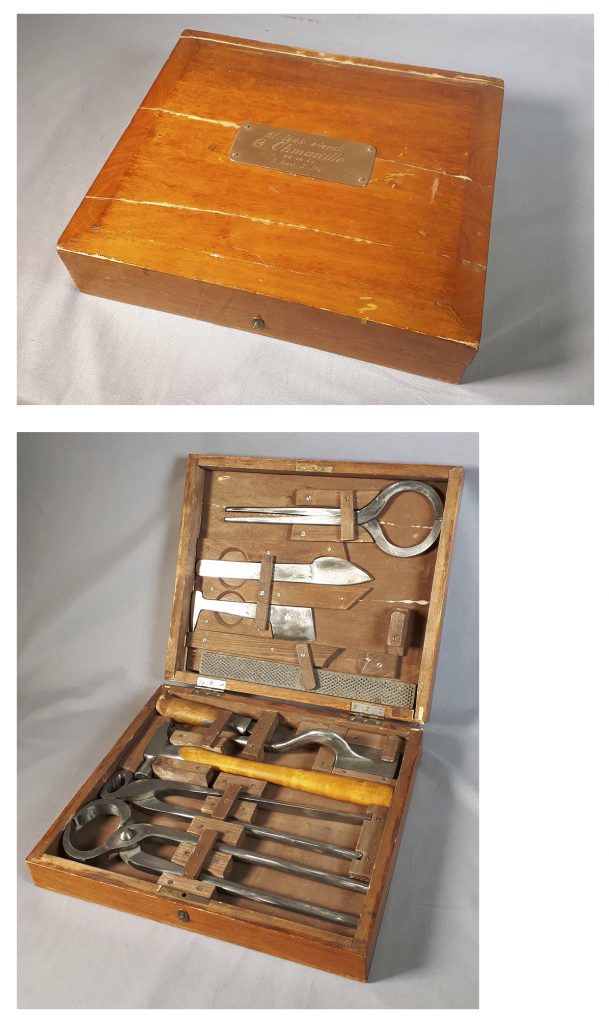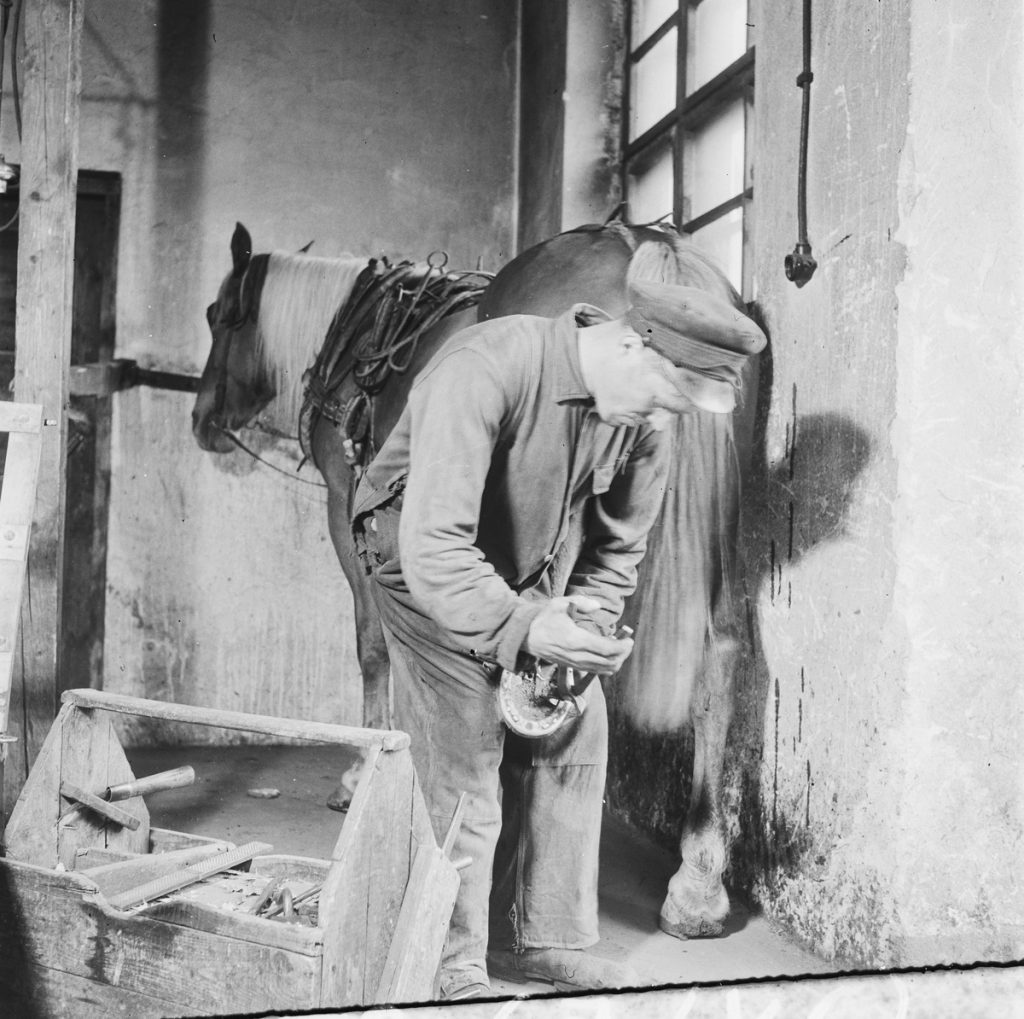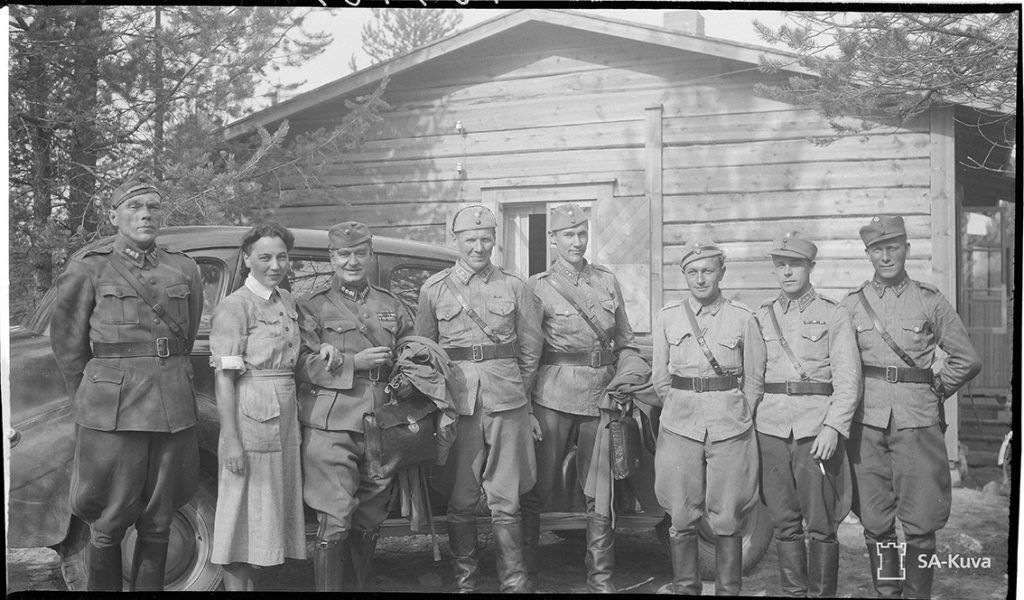This time, our object of the month is a farrier’s wooden toolbox, originally given as a present to Veterinary-Colonel Georg Öhman (1891–1957) in December 1941 – not for Christmas, but for his 50th birthday.

A metal plate attached to the lid of the box indicates that Öhman received the farrier tools as a present from the 5th Equine Hospital. He served in the hospital treating warhorses for four months before he transferred to the Finnish military’s headquarters and took on new duties during the Continuation War between Finland and the Soviet Union (1941–1944). The box includes a basic set of horseshoeing tools, including pullers, nippers, a hammer, a hoof chisel, a hoof knife, a hoof rasp, a few clinch cutters and a hoof tester.

The military career of Jaegar No 1
Georg Öhman was born on 22 December 1891. After completing his matriculation examination in 1912, he headed for Germany to study veterinary medicine in Dresden, graduating in 1917. In Öhman’s youth, studies in veterinary medicine were not yet offered in Finland, which meant that Finns interested in the field moved to cities like Dresden, Hannover, Tartu and Stockholm. It was not until 1945 that the College of Veterinary Medicine was established in Helsinki.
Öhman’s studies took place in a period of worldwide upheaval. Finland’s status as part of the Russian Empire had caused concern ever since the Russification campaigns of the late 19th and early 20th centuries. Activists were dreaming of an independent Finland and, after the outbreak of the First World War, Finnish university students decided to acquire weapons from Germany and attend military training there. On a visit in Finland, Öhman joined the activists and later continued to recruit fellow students abroad after returning to Germany. In February 1915, he and 54 other recruits arrived in the Lockstedt military training camp. Öhman became known as Jaeger No 1 because he was the first Finn to enrol in a course disguised as scout training (‘Pfadfinder’) and to begin Jaeger training.

During the latter part of his career, Öhman worked in various positions in the Finnish military. He returned to the newly independent Finland from Germany with the main body of the Jaegers during the Finnish Civil War in 1918. In the 1920s and 1930s, Öhman served in several positions, including as veterinarian in the 1st Field Artillery Regiment, as hippology (equine studies) instructor at the Military Academy and the Civil Guards’ Officers School, and as a farrier instructor at the Finnish military’s farrier training unit. Indeed, the farrier toolbox was an excellent 50th birthday present for Öhman, who had also provided practical instruction. Öhman continued to work during the Winter War between Finland and the Soviet Union (1939–1940), for example, as the head of the military headquarters’ veterinary department, and during the Continuation War, as a veterinary inspector. After the wars, he was employed as director of the farrier training unit and office manager at the command centre for a decade. He died on 9 December 1957.
A veterinarian and a writer
Apart from being a veterinarian, Öhman was also a talented writer. He wrote two textbooks on horse care that also included information on shoeing. In the book Hevosopin käsikirja upseereille ja hevosystäville (‘Manual of hippology for officers and horse enthusiasts’, 1921), Öhman describes the history of horseshoeing, the structure of the horse foot, hoof care and hoof diseases. According to the manual, horses must be handled calmly, kindly, yet fearlessly during shoeing. Most horses consent to shoeing as long as the farrier is up to the task and causes no pain to the animals.
Öhman’s writing also conveys his love and respect for horses. Animal welfare must always take precedence over one’s own comfort. In the above manual, Öhman states that whether transporting horses by rail, ship or road, the officer and the ‘feedmaster’ (the military professional responsible for the horses in the stables of a single squadron) must always, upon arrival in a rest area, take care of the horses and only then of themselves, however disagreeable that may be. According to another textbook written by Öhman, Sotamiehen hevosoppi (‘Hippology for soldiers’, 1923), a soldier’s honour requires that they keep the horse entrusted to them well-cleaned and -cared for.

Horses in war
In the 1930s and 1940s, Finland was a largely agricultural country. The horse played an indispensable part in agriculture and forestry before machinery became more common on farms. Accordingly, those fighting in the Winter War and the Continuation War were usually experienced horse handlers. During wartime, horses were used to transport equipment, ammunition, field kitchens and artillery particularly to the front line.
In the military, the feedmaster was responsible for feeding and lodging horses. A one-day serving of animal feed during the war included four kilograms each of hay, oats and oat straw. As a result of a feed shortage during the Continuation War, horses received hay, concentrated pulp and straw. The ‘iron ration’ for a horse consisted of two kilograms of pure oats.
During the war, approximately 72,000 civilian horses were enlisted in the military. Of these, some 20,000 died. The large number of horses meant that not only the feedmasters and designated soldiers, but also the military’s veterinary service were kept busy. Equine hospitals and infirmaries treated wounded and sick horses. One of Georg Öhman’s wartime duties included touring such units to ensure that the veterinary care provided was appropriate. In the harsh wartime conditions, the Finnhorse was a sturdy and reliable companion. The death of a familiar horse was mourned like that of a friend.

Katariina Pehkonen, curator
Translation: University of Helsinki Language Services.
Sources:
Sahi, Timo: Elämä jääkärinä ja eläinlääkärinä – Lääkärit jääkäriliikkeessä osa 2. Sotilaslääketieteen aikakauslehti 2/2017, 32–37.
Öhman, Georg: Hevosopin käsikirja upseereille ja hevosystäville. Otava 1921.
Öhman, Georg: Sotamiehen hevosoppi: armeijan oloja ja sotilaille asetettavia vaatimuksia silmällä pitäen laadittu esitys hevosen hoidosta. Otava 1923.
Georg Öhman on the Sotapolku.fi website: https://www.sotapolku.fi/henkilot/-hman_georg_22.12.1891_kerava/, accessed on 3 May 2022.
Hevonen sodassa vuosina 1939–1945: http://www3.lappeenranta.fi/museot/verkkonayttelyt/heihoplaa/sivut/Historiaa-osa4.html, accessed on 3 May 2022.
Simola, Seppo: Hevonen oli korvaamaton resurssi sodassa: https://www.reservilainen.fi/uutiset/hevonen_oli_korvaamaton_resurssi_sodassa, accessed on 3 May 2022.
Öhman, Thomas: Jägare Georg Öhman från Lovisa. https://www.pressreader.com/finland/ostnyland/20180213/281736974916504, accessed on 23 February 2022.
Kengitysvälineet, a video presentation of farrier tools on the website of the Finnish Equine Information Centre: https://hevostietokeskus.fi/i/videot/kengitys2/kengitysvalineet, accessed on 4 May 2022.
